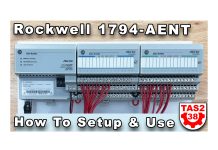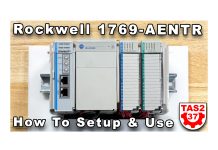
In a previous article I discussed setting the dip switches, applying 24 VDC power, and using a web browser to modify the configuration in an Allen Bradley E300 Module.
In this article, I want to go a bit further and discuss the steps in adding an E300 module to your RSLogix or Studio 5000 project and how to work with the module to get it functioning.

Note: If needed, refer to my previous article, “Getting Started with an Allen Bradley E300 Overload Module” for information about powering up and setting the IP address of your E300 module.
Installing Add-on Profiles:
If you try to add an E300 communication module to the I/O configuration tree of your studio 5000 project, you will not find the needed part numbers.
Before you can add the module in the I/O Configuration tree, you will need to download and install the proper Add-On-Profiles for an E300 module such as “RAE300_AOP_v06.03.64_Release”:
Be sure to follow all these steps when adding the AOP:
Step 1) Download the Add-On-Profiles from Rockwell’s PCDC (Product Compatibility and Download Center)
 Step 2) Shut down any and all Rockwell Applications, including RSLinx.
Step 2) Shut down any and all Rockwell Applications, including RSLinx.
Step 3) Unzip and Install the Add-On-Profile(s)
Step 4) After Installation, you will be able to add the E300 module in your Studio 5000 application
Adding the E300 to the I/O Configuration Tree:
The next step is to add the E300 to you project’s I/O Tree by following these steps:
Note: In this example we have a 1756-EN2T module in our I/O Configuration Tree that will communicate with the E300 module, but in many real-world applications you will be using a 1756-EN2TR to utilize a DLR (Device Level Ring) topology.
Step 1) Right-Click on your Ethernet module (in our example, an EN2T) and select “Add-Module”:
Step 2) Select the part number for the E300 Communication Module which is “193-ECM-ETR”:
Step 3) Select “OK”

Notes:
On the “General Tab” of the E300, you can see the general information of the E300 Module.
For other module configuration, click the “Change” button on the right side of the page as shown in the screenshot below. This window contains all of the parts used in your E300 assembly.


Test Lab Setup:
In this lab, I am using the following part numbers (this will most likely be different with your setup.)
- Sensing Module – 193-ESM-IG-30A-C23
- Control Module – 193-EIO-63-24D

Controller Tags:
As with adding any I/O module in ControlLogix, the tags for your E300 will automatically be added to the controller tag database.
If you are familiar with other I/O Modules, you will notice that the E300 will have three types of tags: “C”, “I” and “O” – they respectively stands for “Configuration”, “Inputs” and “Outputs”.
Configuration Tags:
Use these tags to set parameters such as FLA (Full Load Amps) of your motor.
This screenshot is only a section of the tags and is only a small example of the many configuration parameters available.

Input Tags:
These are the parameter monitoring tags from the E300 device.
This screenshot is only a section of the tags and is only a small example of the many monitoring parameters available. There is an abundance of information here that you will want to forward to your HMI displays.

Output Tags:
These are the writable commands to the E300 device for things such as start/stop and reset faults. This is only a small section of the available writes to the device that are available.

A typical Motor Control Application in Ladder Logic:

Reference:
Conclusion:
While there are many steps and options available, the basic setup of an E300 in your control system can be accomplished in a matter of minutes.
Hopefully this guide will help you with the basic setup and configuration options of an Allen-Bradley E300 Overload Module.
Written by Brandon Cooper
Senior Controls Engineer and Freelance Writer
Have a question? Join our community of pros to take part in the discussion! You'll also find all of our automation courses at TheAutomationSchool.com.
Sponsor and Advertise: Get your product or service in front of our 75K followers while also supporting independent automation journalism by sponsoring or advertising with us! Learn more in our Media Guide here, or contact us using this form.
- Things I’ve Learned Travelling for Work (2) - July 17, 2025
- Things I’ve Learned Travelling for Work (1) - July 10, 2025
- Emulating an Allen-Bradley E3 or E3 Plus - June 30, 2025

Discover more from The Automation Blog
Subscribe to get the latest posts sent to your email.



